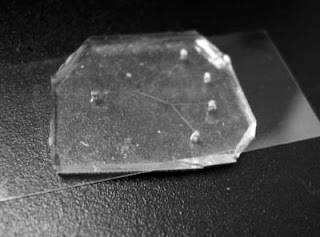WEST LAFAYETTE, Ind. - Purdue University researchers have reproduced portions of the female breast in a tiny slide-sized model dubbed "breast on-a-chip" that will be used to test nanomedical approaches for the detection and treatment of breast cancer.
The model mimics the branching mammary duct system, where most breast cancers begin, and will serve as an "engineered organ" to study the use of nanoparticles to detect and target tumor cells within the ducts.
Sophie Lelièvre, associate professor of basic medical sciences in the School of Veterinary Medicine, and James Leary, SVM Professor of Nanomedicine and professor of basic medical sciences in the School of Veterinary Medicine and professor of biomedical engineering in the Weldon School of Biomedical Engineering, led the team.
"Breast cancer is the most common cancer in women in most countries, and in the U.S. alone nearly 40,000 women lost their lives to it this past year," said Lelièvre, who is associate director of discovery groups in the Purdue Center for Cancer Research and a leader of the international breast cancer and nutrition project in the Oncological Sciences Center. "We've known that the best way to detect this cancer early and treat it effectively would be to get inside the mammary ducts to evaluate and treat the cells directly, and this is the first step in that direction."
Such tests could not be done using standard models that grow cells across a flat surface in a plastic dish, so the team created the artificial organlike model in which living cells line a three-dimensional replica of the smallest portions of the mammary ducts.
Leary is internationally known for his nanofabrication work using photolithography to build tiny, precise structures on thin pieces of silicon to create high-speed cell sorting and analysis tools. He used the same techniques to build a mold of branching channels out of a rubberlike material called polydimethylsiloxane. The channels are about 5 millimeters long of various diameters from 20 microns to 100 microns, roughly the diameter of a human hair, that match what is found near the end of the mammary duct system.
Lelièvre, whose group is one of the few in the world able to successfully grow the complicated cells that line the mammary ducts, coaxed the cells to grow within the mold and behave as they would within a real human breast.
"The cells within the breast ductal system have a very specific organization that has proven difficult to obtain in a laboratory," Lelièvre said. "The cells have different sides, and one side must face the wall of the duct and the other must face the inner channel. Reproducing this behavior is very challenging, and it had never been achieved on an artificial structure before."
The team coated the mold in a protein-based substance called laminin 111 as a foundation for the cells that allows them to attach to the mold and behave as they would inside the body, Lelièvre said.
Because injecting the delicate cells into the finished channels of the mold caused too much damage, the team created a removable top for the channels.
"The design of the U-shaped channels and top was necessary for us to be able to successfully apply the cells, but it also allows us to make changes quickly and easily for different tests," Lelièvre said. "We can easily introduce changes among the cells or insert a few tumor cells to test the abilities of the nanoparticles to recognize them. The design also makes it very easy to evaluate the results as the entire model fits under a microscope."
A paper detailing the team's work, which was funded by the U.S. Department of Defense, is published in the current issue of Integrative Biology. In addition to Lelièvre and Leary, co-authors include graduate student Meggie Grafton, research associate Lei Wang and postdoctoral researcher Pierre-Alexandre Vidi.
The team has demonstrated that nanoparticles can be moved within the bare channels of the mold filled with fluid, but has not yet moved nanoparticles through the finished model lined with living cells, Lelièvre said.
The team next plans to create and test nanoparticles with a slippery surface that will prevent them from sticking to the cells as they travel through the channels and coatings that contain antibodies to target and attach to specific types of cancerous and precancerous cells, she said.
"Although we are at the very beginning stages of this work, we are hopeful that this nanomedical approach will one day save lives and provide patients with an easier road to recovery," Lelièvre said. "The successful creation of this model is an important milestone in this work and it is a testament to what can be accomplished through multidisciplinary research." ###
Lelièvre and Leary are both members of the Purdue Center for Cancer Research and the Oncological Sciences Center. Leary also is a member of the Birck Nanotechnology Center and Bindley Bioscience Center at Purdue's Discovery Park.
Writer: Elizabeth K. Gardner, 765-494-2081, ekgardner@purdue.eduSources: Sophie Lelièvre, 765-496-7793, lelievre@purdue.edu James Leary, 765-494-7280, jfleary@purdue.edu Related Web sites: Purdue Center for Cancer Research: www.cancerresearch.purdue.edu/ Sophie Lelièvre: www.gradschool.purdue.edu/PULSe/faculty James Leary: www.purdue.edu/dp/mcf/
Contact: Elizabeth K. Gardner ekgardner@purdue.edu 765-494-2081 Purdue University
















No comments:
Post a Comment